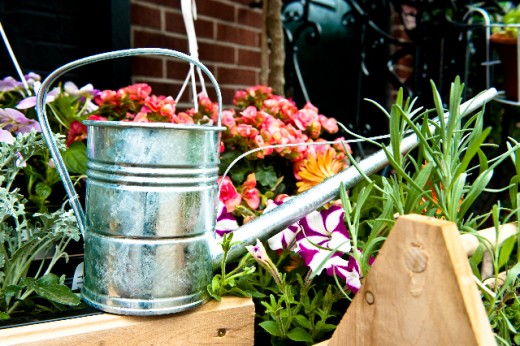Editor’s Note: This article was originally published on May 13, 2010. We’re re-publishing articles in this series so that we can share the wonderful Kimberly Sevilla’s knowledge and experience with you, because, hey, it’s spring! Again!

Photo by Jessi Bautista
Q: I’d like to create a garden, and I have a small balcony, what can I grow?
There are lots of things that you may grow on a balcony, you just have to consider what your goals are. You can grow everything from flowers and herbs to vegetables and fruits. Throughout the ages, container gardening has been extremely popular and a convenient way for urban dwellers to grow delicacies on small patios and balconies.
Fortunately for us, there are lots of fruits and vegetables that have been specifically bred to grow in small spaces and lots of containers available for us to use.
Ask yourself what you want to do. Do you like cut flowers on your night table, do you like to cook? Do you want to make potpourri or repel mosquitos and other critters; or do you just want something pretty to look at? There are lots of plants that you can use and just because you are growing yours in a window box or patio planter doesn’t mean that you have to stick to red geraniums and striped petunias.
 Herbs make great container plants, as well as strawberries and lettuce. You can also grow cherry tomatoes, peppers, cucumbers, and eggplants quite easily. I met a woman once who grew pumpkins and gladiolas in her window box in Paris, so really, almost anything is possible. I like to grow cucumbers up a trellis and plant lettuce at the base with nasturtiums, those all fit nicely together in a standard-sized window box and look pretty too. Check out the back of the seed packets or the tags on plant starts and look for plants that will grow to about 2′ or under when mature or ones labeled patio, or dwarf, those are safe bets for small spaces.
Herbs make great container plants, as well as strawberries and lettuce. You can also grow cherry tomatoes, peppers, cucumbers, and eggplants quite easily. I met a woman once who grew pumpkins and gladiolas in her window box in Paris, so really, almost anything is possible. I like to grow cucumbers up a trellis and plant lettuce at the base with nasturtiums, those all fit nicely together in a standard-sized window box and look pretty too. Check out the back of the seed packets or the tags on plant starts and look for plants that will grow to about 2′ or under when mature or ones labeled patio, or dwarf, those are safe bets for small spaces.
There are a lot of containers available to use some are even self watering. You can even use found items such as olive oil cans, 5 gallon pickle buckets or even old tires if you like. The important thing is to have a nice sized container so you soil doesn’t dry out too fast. 4″ pots may look cute, but you may have to water the plants a couple of times a day, especially if it is windy and hot. You can also use plant sitters which you attach a bottle to or those as-seen-on-tv globes, which really do work. Another trick is to use a product called soil moist which absorbs up to 40 times its weight in water and releases it back into the soil when the plants need it.
Make sure you use a good quality potting soil and one that is labeled organic if you are growing things that you are eating. By using organic soil, your herbs and vegetables will taste better and you will be avoiding the chemicals that are in most commercial soil mixes that you find at the corner shops and at hardware stores. Remember to fertilize your plants by using compost or a dry organic fertalizer. The dry fertilizer will slowly release nutrients over time and is more effective than liquid nutrients which will quickly leach out of containers.
 Q: I don’t get much light in my garden, what plants are good for me?
Q: I don’t get much light in my garden, what plants are good for me?
Plants need sun to grow, this is true, however, some like it on the shady side. If you get at least 6 hours of direct sun, you can grow almost anything. You may not get a the same yield as you would in a full sun situation, but it is possible. This means that you can grow peppers, tomatoes, basil and other sun lovers in you less than ideal sun situation.
If your planting environment is placed under a tree and gets less than 6 hours, you can easily plant lettuce and radishes in the early spring and enjoy them longer into the summer, lettuce doesn’t mind a little shade if it gets a good start.
You can also plant; mint, ferns, hosta, alpine strawberries and my favorites; angelica and hyssop. Angelica and hyssop grow super tall and attract butterflies, angelica can be used to make candied angelica and hyssop can be used in tea. They both grow fast so you can get a 6′ showy plant, with flowers, in a shady spot in one season for very little cost (under $15).
Q: Help! I have centipedes in my plant, what can I do?
Sometimes centipedes lay their eggs in soil at the growers greenhouse. They rest for a few months and then hatch unfortunately sometimes this happens after you bring your plants home. We get a call maybe once a year from someone with this situation. When plants are purchased and sold, they are inspected for bugs and disease but there is no way for us to tell if a centipede has laid her eggs other than by seeing little centipedes. We like centipedes, they help break down our compost and they are important garden critters but we certainty wouldn’t want them in our house.
The good news is that it is pretty easy to take care of. We recommend the following. Repot the plant with new potting soil, gently shake off as much as the old soil as possible. Remove and dispose of any little critters that you see. Scrub your old pot with a pot brush and a solution of vinegar and water with a dash of liquid soap, Dr. Bronner’s tea tree or lavender soap is a good choice. Rinse off the leaves with water and spray the top of the soil with an organic insect spray, there are a few on the market made with Rosemary Oil, they smell great and are completely safe for pets and children. Repeat the spray on the soil once a week until no critters are found.
If you like you can also tie the plant up inside a clear plastic bag just to make sure no one escapes.
I would be happy to answer any gardening questions you may have. Please send them to lavender@roseredandlavender.com

Kim Sevilla and daughter Lavender. Photo by Amy Wise
Warmest Regards,
Kimberly Sevilla, Rose Red & Lavender
653 Metropolitan Ave
Williamsburg, NY 11211
Flowers, Gifts and Beautiful Things
718-486-3569
Leave a Reply